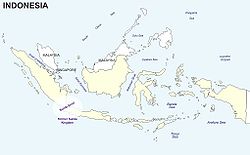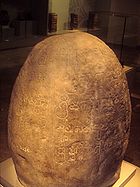
Kingdoms of Sunda
Encyclopedia

Indonesia
Indonesia , officially the Republic of Indonesia , is a country in Southeast Asia and Oceania. Indonesia is an archipelago comprising approximately 13,000 islands. It has 33 provinces with over 238 million people, and is the world's fourth most populous country. Indonesia is a republic, with an...
in 1945 AD.
The history includes several eras:
- SalakanagaraSalakanagaraSalakanagara kingdom is the first historically recorded Indianized kingdom in Western Java, created by Indian trader after marrying a local Sundanese princess. This Kingdom existed between 200-362 AD....
- TarumanagaraTarumanagaraTarumanagara or Taruma Kingdom or just Taruma is an early Sundanese Indianized kingdom, whose fifth-century ruler, Purnavarman, produced the earliest known inscriptions on Java island...
(Capital at Chandrabhaga/Bekasi & Sundapura) - The United Kingdom of Sunda and Galuh (or Sunda-Galuh with capital at Pakuan Pajajaran; Saunggalah and Kawali)
- The Sultanate of Banten & The Sultanate of CirebonThe Sultanate of CirebonThe Sultanate of Cirebon was a sultanate in West Java founded in the sixteenth century. It is said to have been founded by Sunan Gunungjati, who also established the Sultanate of Banten....
Salakanagara

Java
Java is an island of Indonesia. With a population of 135 million , it is the world's most populous island, and one of the most densely populated regions in the world. It is home to 60% of Indonesia's population. The Indonesian capital city, Jakarta, is in west Java...
island) is Salakanagara (lit: country of silver). Salakanagara was established in Year 52 Saka (130/131 AD). The location of the kingdom is believed to be in Teluk Lada, Pandeglang city, the city which is famous for metal works. (Pandeglang, or pande gelang is Sundanese
Sundanese language
Sundanese is the language of about 27 million people from the western third of Java or about 15% of the Indonesian population....
words for the maker of metal bracelets or armlets). Dr. Edi S. Ekajati, Sundanese historian, conjectured that the location of the capital city of the kingdom was in current Merak City (lit: silvery city). Some people also conjectured that the kingdom was situated around Mount Salak
Mount Salak
Mount Salak is an eroded volcanic range in West Java, Indonesia. Several satellite cones occur on the southeast flank and on the northern foot. Two craters are found at the summit. Mount Salak has been the site of a geothermal exploration.. The name Salak is come from salak fruit.- See also :*...
, based on the pronunciation of the words Salaka and Salak which are almost the same.
It is very probable that Argyre
Argyre
In Greek and Roman mythology, Argyre was a mythical island of silver, located in the east. The name comes from the Greek argyros ....
or Argyros at the west end of Iabadiou mentioned by Claudius Ptolemaeus Pelusiniensis (Ptolemy
Ptolemy
Claudius Ptolemy , was a Roman citizen of Egypt who wrote in Greek. He was a mathematician, astronomer, geographer, astrologer, and poet of a single epigram in the Greek Anthology. He lived in Egypt under Roman rule, and is believed to have been born in the town of Ptolemais Hermiou in the...
) of Alexandria (87-150 AD), in his work “Geographike Hypergesis” is Salakanagara.
A report from China in 132 said that Pien, the king of Ye-tiau, lent gold stamp and violet ribbon to Tiao-Pien. The word Ye-tiau is interpreted by G. Ferrand, a French historian, as Javadwipa and Tiao-pien referred to Dewawarman.
The Salakanagara Kingdom was then replaced by the Tarumanagara Kingdom.
Tarumanagara
The heyday of the Tarumanagara Kingdom was between the fourth and seventh centuries. The historical record of the kingdom is a sketchy account by a Chinese traveler and several rock inscriptions discovered in the western part of Java island. These sources agree that the most powerful king of Tarumanegara was Purnavarman, who conquered neighbouring countries.Sunda Kingdom (United Kingdom of Sunda and Galuh)
The United Kingdom of Sunda and Galuh was a kingdom in West JavaWest Java
West Java , with a population of over 43 million, is the most populous and most densely populated province of Indonesia. Located on the island of Java, it is slightly smaller in area than densely populated Taiwan, but with nearly double the population...
and western part of Central Java
Central Java
Central Java is a province of Indonesia. The administrative capital is Semarang. It is one of six provinces on the island of Java.This province is the province of high Human Development in Indonesia and its Points Development Index countries is equivalent to Lebanon. The province of Central Java...
territory which emerged as a unification of the Sunda kingdom
Sunda Kingdom
The Sunda Kingdom was a Hindu kingdom located on the western part of Java from 669 to around 1579, covering areas of present-day Banten, Jakarta, West Java, and the western part of Central Java...
and the Galuh kingdom
Galuh Kingdom
Galuh Kingdom was a kingdom in Tanah Sunda , Indonesia. It was established following the collapse of the Tarumanagara kingdom. Galuh and the Sunda kingdom, another Sundanese kingdom, established the United Kingdom of Sunda and Galuh....
. The two kingdoms themselves were a result of the division of the former Tarumanagara
Tarumanagara
Tarumanagara or Taruma Kingdom or just Taruma is an early Sundanese Indianized kingdom, whose fifth-century ruler, Purnavarman, produced the earliest known inscriptions on Java island...
kingdom. This kingdom was often just called the Sunda Kingdom based on historical primary resources such as stone inscriptions and old literature.
The area covered by the Sunda kingdom until early in the 16th century
Based on the travel records of Prince Bujangga Manik
Bujangga Manik
Bujangga Manik is one of the precious remnants of Old Sundanese literature. It is told in octosyllabic lines – the metrical form of Old Sundanese narrative poetry – in a palm leaf kept in the Bodleian Library in Oxford since 1627 or 1629...
, a Hindu Sundanese monk who visited all of the holy Hindu sites in Java and Bali
Bali
Bali is an Indonesian island located in the westernmost end of the Lesser Sunda Islands, lying between Java to the west and Lombok to the east...
islands at the beginning of the sixteenth century AD, in his lontar manuscripts, which are saved in the Bodleian Library
Bodleian Library
The Bodleian Library , the main research library of the University of Oxford, is one of the oldest libraries in Europe, and in Britain is second in size only to the British Library...
of Oxford University of England since the 16th century, the border of the Sunda kingdom in the west is the Sunda Strait
Sunda Strait
The Sunda Strait is the strait between the Indonesian islands of Java and Sumatra. It connects the Java Sea to the Indian Ocean...
and in the east is the Cipamali River (present day Brebes River) and Serayu River
Serayu River
-References:...
in Central Java Province.
Historical record
The earliest time of a reference to the name Sunda being used to identify a kingdom, is written on the Prasasti Kebon Kopi II stone inscription of 458 Saka (536 AD) and copperplate letters of the fifteenth century with royal instructions telling the existence of the Sunda kingdom. Another reference to the kingdom is the Sanghiyang Tapak inscriptions. There are also certain Chinese sources concerning the Sunda kingdom; the first source is a report from Chu-fan-chi from 1178 to 1225 AD and the second source is the Chinese book "shun-feng hsiang-sung" from about 1430 AD. European explorers also report the existence of the Sunda kingdom. One of the explorers was Tomé Pires
Tomé Pires
Tomé Pires was an apothecary from Lisbon who spent 1512 to 1515 in Malacca immediately after the Portuguese conquest, at a time when Europeans were only first arriving in South East Asia...
from Portugal. Tomé Pires, in his report “Summa Oriental (1513–1515)”, wrote about his journey to the Sunda kingdom. Diogo do Couto also wrote that the Sunda kingdom is thriving and abundant; it lies between Java and Sumatra, having between it and the latter the Straits of Sunda. Besides that, the Portuguese made a peace treaty with the Sunda kingdom in 1522 AD. This treaty is better known as the Luso Sundanese Treaty of Sunda Kalapa. Henrique Leme erected a padrão
Padrão
A padrão was a large stone cross inscribed with the coat of arms of Portugal that was placed as part of a land claim by numerous Portuguese explorers during the Portuguese Age of Discovery...
to memorialize the treaty.
In the early sixteenth century AD, the kingdom was divided into three smaller kingdoms, including the Sultanate of Banten
Sultanate of Banten
The Sultanate of Banten was founded in the 16th century and centered in Banten, a port city on the northwest coast of Java; the contemporary English spelling of both was Bantam...
and the Sultanate of Cirebon
The Sultanate of Cirebon
The Sultanate of Cirebon was a sultanate in West Java founded in the sixteenth century. It is said to have been founded by Sunan Gunungjati, who also established the Sultanate of Banten....
. But many historical resources tell the existence of the third kingdom in south east of West Java, i.e the Sumedanglarang Kingdom.
The Sultanate of Banten
In 1524/1525, Sunan Gunung Jati from CirebonCirebon
Cirebon is a port city on the north coast of the Indonesian island of Java. It is located in the province of West Java near the provincial border with Central Java, approximately 297 km east of Jakarta, at .The seat of a former Sultanate, the city's West and Central Java border location have...
together with Demak Sultanate armies seized the port of Banten from the control of the Sunda kingdom
Sunda Kingdom
The Sunda Kingdom was a Hindu kingdom located on the western part of Java from 669 to around 1579, covering areas of present-day Banten, Jakarta, West Java, and the western part of Central Java...
, and established The Sultanate of Banten affiliating with the Demak Sultanate. Islam preachers have penetrated and introduced people to the peaceful way of life of Islam, and as a result many people in the region embraced Islam as their belief.
During 1552-1570, Maulana
Maulana
Mawlānā is an Arabic word literally meaning "our lord" or "our master" ....
Hasanudin
Hasanudin
Mulana Hasanudin was the second ruler of the Banten Sultanate, following the mysterious Sunan Gunungjati when he left to found Cirebon. Hasanudin reigned from c. 1552 to 1570....
ruled as the first Sultan of Banten.
Reaching its golden age during the first half of the seventeenth century, the Sultanate of Banten lasted for 300 years (1526–1813 AD). The grandeur of this Sultanate has left us with a plethora of archeological remains and historical records. It is for this reason that there will never be a lack of sources in retracing the history of the Sultanate of Banten.
The Sultanate of Cirebon
The Sultanate of CirebonThe Sultanate of Cirebon
The Sultanate of Cirebon was a sultanate in West Java founded in the sixteenth century. It is said to have been founded by Sunan Gunungjati, who also established the Sultanate of Banten....
(Indonesian: Kesultanan Cirebon, Sundanese: Kasultanan Cirebon) was a sultanate in Sunda
Sunda Kingdom
The Sunda Kingdom was a Hindu kingdom located on the western part of Java from 669 to around 1579, covering areas of present-day Banten, Jakarta, West Java, and the western part of Central Java...
land, founded in the sixteenth century. It is said to have been founded by Sunan Gunungjati
Sunan Gunungjati
Sunan Gunungjati was one of the Wali Songo, or Nine Apostles of Islam. He founded the Sultanate of Bantam, as well as the port town of Cirebon on the north coast of Java...
, who also established The Sultanate of Banten.

